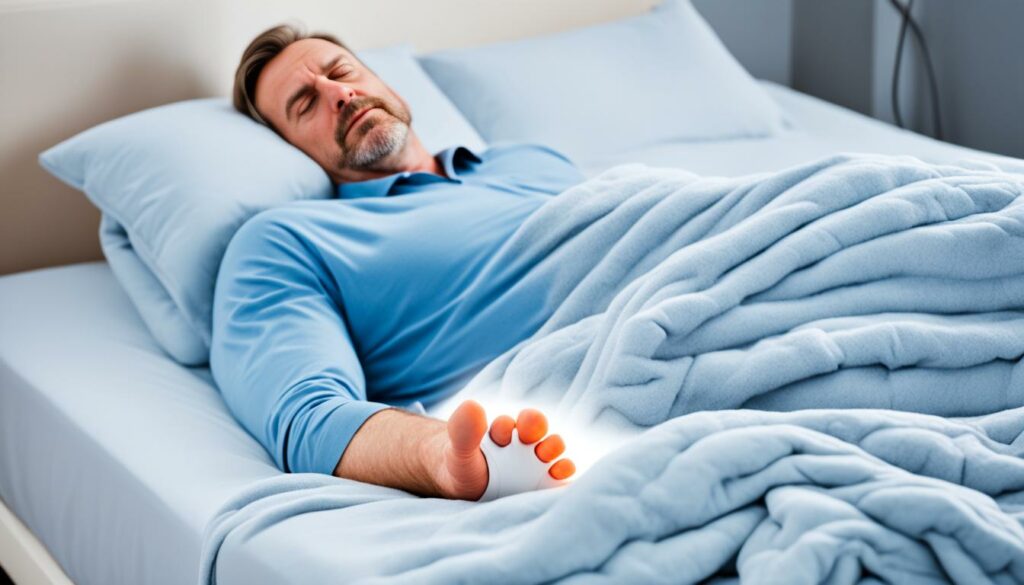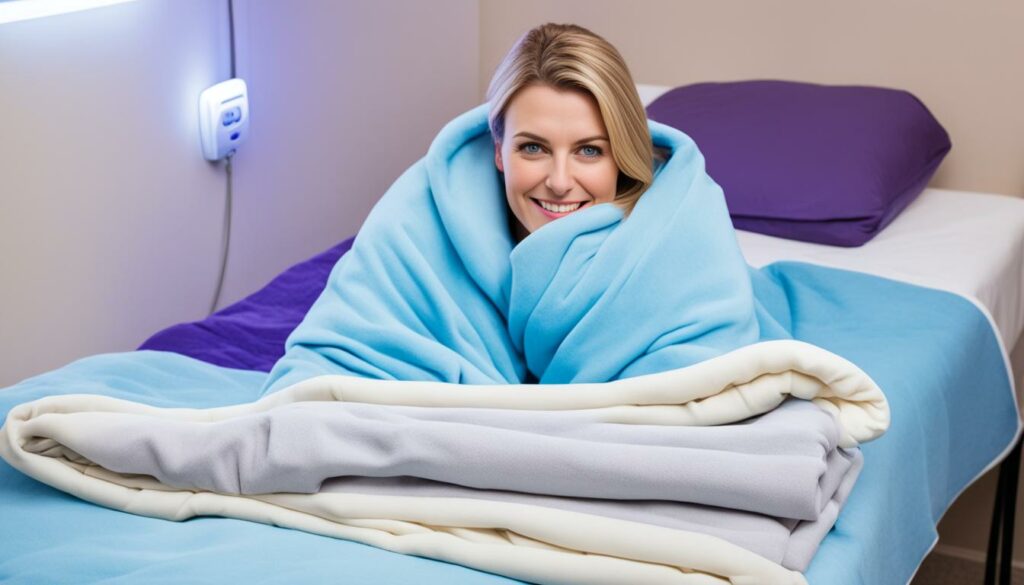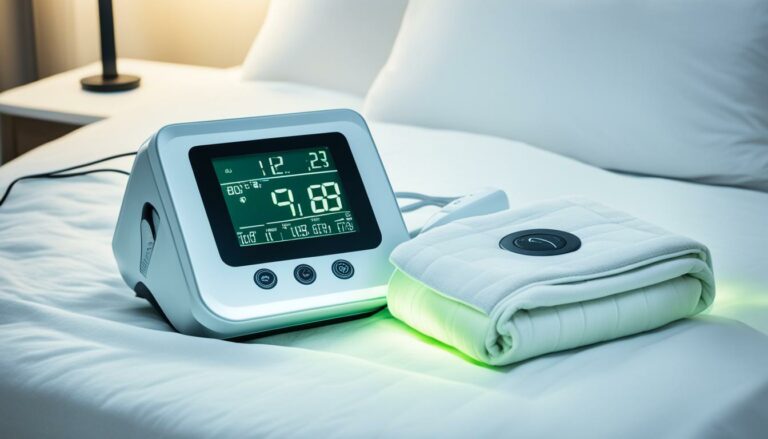Heated Blankets & Circulation: Good or Bad?
Eric Christie stands as a luminary in the bedding industry, with a career spanning nearly four decades since the early 1980s. His journey through the world of bedding has seen him wear many hats – a manufacturer, designer, and retailer, showcasing his versatility and expertise in Read more...
pillowsandbedsheets.com and its partners may earn a commission if you purchase a product through one of our links
Are you a fan of cozying up under a warm, electric blanket during the chilly winter months? While heated blankets can provide a soothing and comfortable experience, it’s important to understand the potential health risks they may pose, particularly when it comes to circulation. In this article, we’ll explore the impact of heated blankets on circulation, addressing common concerns and providing guidelines to help you make informed decisions about their usage.
Key Takeaways:
- Electric blankets can be safe when used correctly, but certain individuals, such as those with circulation problems, should take caution.
- There is no conclusive evidence linking electric blankets to cancer.
- Pregnant women and individuals with diabetes are advised to avoid using electric blankets due to potential risks.
- Follow safety guidelines to reduce the risk of burns or injuries while using electric blankets.
- Exploring alternative methods for warmth, such as hot water bottles or heat pads, can be a safer option for some individuals.
Are Electric Blankets Linked to Cancer?
There has been speculation about the possible connection between electric blankets and cancer due to the electromagnetic fields (EMFs) they emit. However, research suggests that the low- to mid-frequency EMFs produced by electric blankets are non-ionizing and do not damage cells or DNA. Therefore, there is no conclusive evidence linking electric blankets to cancer. It is important for individuals with circulation issues to consult with a healthcare professional to ensure using electric blankets is safe for them.
Electric Blankets and Pregnancy
If you are pregnant, it is advisable to avoid using electric blankets due to the potential health risks they pose. Electric blankets generate non-ionizing radiation, which has raised concerns regarding its impact on pregnancy. While there is still no conclusive evidence linking electric blankets to pregnancy complications, some studies have indicated a potential increase in the risk of pregnancy loss with exposure to non-ionizing radiation.
To ensure the well-being of both you and your baby, it is recommended that you consult with a medical professional before using an electric blanket during pregnancy. They will be able to provide personalized advice based on your specific circumstances and help you understand any potential risks involved.
Discussing your concerns with a healthcare provider is an essential step in making informed decisions about your prenatal health. They can guide you on how to safely stay warm throughout your pregnancy without relying on electric blankets. Remember that your safety and the well-being of your baby are the top priorities during this crucial time.
Other Precautions for Pregnant Individuals
Alongside avoiding electric blankets, there are other precautions you can take to ensure a healthy pregnancy:
- Avoid exposure to harmful substances, such as tobacco smoke and chemicals.
- Adopt a balanced diet and stay hydrated.
- Engage in regular prenatal check-ups with your healthcare provider.
- Get sufficient rest and prioritize sleep.
- Avoid activities that could cause physical harm or strain.
- Follow any additional guidelines or recommendations provided by your healthcare professional.
By taking these necessary precautions and seeking guidance from your healthcare provider, you can ensure a safe and smooth pregnancy journey.
“During pregnancy, it is crucial to prioritize the health and well-being of both you and your baby. When it comes to the use of electric blankets, consulting with a medical professional can help you make an informed decision and minimize any potential risks.”
| Potential Risks of Electric Blankets for Pregnant Individuals | Precautions to Consider |
|---|---|
| Exposure to non-ionizing radiation | Avoid using electric blankets |
| Potential increase in risk of pregnancy loss | Consult with a healthcare provider for personalized advice |
Electric Blankets and Diabetes
People with diabetes, especially those with neuropathy, may experience negative effects on circulation when using heated blankets. Neuropathy can impair the body’s ability to properly sense heat, making it challenging for individuals to gauge the temperature of the blanket accurately.
Considering the potential risks, it is advisable for people with diabetes to explore alternative methods for staying warm and discuss the use of heated blankets with their healthcare provider. This ensures they make informed decisions about whether using an electric blanket is safe for them.

| Alternative Methods for Staying Warm |
|---|
| 1. Layering thick blankets or duvets |
| 2. Using hot water bottles or heat pads |
| 3. Wearing warm socks and head coverings |
| 4. Choosing brushed fabrics for bedsheets |
| 5. Addressing any drafts in the bedroom |
By considering these alternative methods, individuals with diabetes can find safe and effective ways to stay warm without compromising their circulation and overall well-being.
Safety Guidelines for Using Electric Blankets
When using electric blankets, it is essential to prioritize your safety and minimize any potential health risks. Follow these guidelines to ensure the safe use of electric blankets:
- Read the manufacturer’s instructions: Familiarize yourself with the specific usage guidelines provided by the manufacturer. Different electric blankets may have specific recommendations for temperature, duration of use, and maintenance.
- Inspect the blanket: Regularly check your electric blanket for any signs of wear and tear, such as frayed cords or exposed wires. If you notice any damage, discontinue use immediately and replace the blanket.
- Keep the blanket flat and smooth: Avoid folding or bunching up the electric blanket while it is in use. Make sure the blanket is spread out evenly and does not have any creases or wrinkles.
- Avoid using with other bedding: Do not layer additional blankets, comforters, or other bedding on top of the electric blanket. This can trap heat and increase the risk of overheating.
- Do not use a heated blanket while sleeping: It is advisable to turn off the electric blanket before going to bed. Sleeping directly on a heated blanket can increase the risk of burns or overheating during the night.
- Use a timer or automatic shut-off feature: If your electric blanket has a timer or automatic shut-off feature, utilize it to prevent prolonged exposure to heat. This can help avoid excessive heating and reduce the risk of burns or accidents.
- Avoid using electric blankets on infants, young children, and pets: The safety of electric blankets for infants, young children, and pets has not been fully established. To ensure their well-being, it is best to use alternative methods for keeping them warm.
- Monitor for any adverse effects: Pay attention to any discomfort, skin irritation, or other adverse effects that may arise from using the electric blanket. If you experience any negative symptoms, discontinue use and consult a healthcare professional.
Following these safety guidelines can help mitigate the potential health risks associated with electric blankets, particularly concerning circulation. Prioritizing your safety and well-being is crucial when using any electrical device.
 Remember: It is important to exercise caution and make informed decisions regarding the use of electric blankets, especially if you have preexisting health conditions or concerns about their impact on circulation. Always consult with a healthcare professional for personalized advice.
Remember: It is important to exercise caution and make informed decisions regarding the use of electric blankets, especially if you have preexisting health conditions or concerns about their impact on circulation. Always consult with a healthcare professional for personalized advice.
Alternatives to Electric Blankets for Staying Warm
While electric blankets are a popular choice for staying warm during colder nights, they may not be suitable for everyone, especially those with circulation problems. Fortunately, there are several alternative methods that can provide warmth without the potential risks associated with electric blankets.
1. Hot Water Bottles or Heat Pads
Hot water bottles and heat pads are effective options for targeted warmth. Fill a hot water bottle with warm water or use a heat pad to provide localized heat to areas such as your feet or abdomen, promoting circulation without the potential dangers of electric blankets.
2. Warm Socks and Head Coverings
Keeping your extremities warm can significantly improve overall body temperature. Wear warm socks and head coverings, such as a beanie or sleep cap, to trap body heat and prevent it from escaping, ensuring a cozy sleep without relying on electric blankets.
3. Brushed Fabrics for Bedsheets
Opt for bedsheets made from brushed fabrics like flannel or microfiber. These materials have a soft, fuzzy texture that provides additional insulation, helping to retain body heat and keep you warm throughout the night.
4. Layers with Duvets and Thick Blankets
Create layers of warmth by using duvets and thick blankets. Layering bedding not only adds extra insulation but also allows you to adjust the warmth as needed by removing or adding blankets. This method provides customizable warmth without the concerns associated with electric blankets.
5. Addressing Drafts in the Bedroom
Drafts can make your bedroom feel colder, even with the use of electric blankets. Check for drafts around windows and doors and seal any gaps or cracks. You can also use draft stoppers or door sweeps to prevent cold air from entering the room, ensuring a comfortable sleep environment without relying solely on electric blankets.
By exploring these alternatives, you can enjoy a cozy night’s sleep without compromising your circulation or exposing yourself to the potential risks associated with electric blankets.

A Comparison of Electric Blankets and Alternative Methods for Staying Warm
| Electric Blankets | Alternatives | |
|---|---|---|
| Health Risks | May pose dangers, especially for individuals with circulation problems | Generally safe |
| Customizable Warmth | Can adjust heat levels | Varies depending on the method |
| Localized Warmth | No | Yes (with hot water bottles or heat pads) |
| Targeted Circulation Improvement | No | Yes (with hot water bottles or heat pads) |
| Energy Efficiency | Varies depending on the model | Varies depending on the method |
As seen in the table, alternatives to electric blankets offer various benefits such as customized warmth, localized heat, and improvements in circulation, while minimizing the potential health risks associated with electric blankets for individuals with circulation problems. Consider these alternatives for a comfortable and safe sleep environment.
Conclusion
Overall, electric blankets can provide a safe and cozy way to stay warm during colder nights. However, it’s crucial to assess your individual circumstances before using one. Consider factors like pregnancy, diabetes, and circulation issues, as they may increase the potential risks associated with electric blankets.
To ensure your safety, always follow the manufacturer’s guidelines and safety recommendations when using an electric blanket. This includes checking for any signs of wear and tear, avoiding folding or bunching the blanket, and never using it while sleeping with pets or young children. In addition, monitor the temperature settings and never leave it unattended for long periods of time.
If you are concerned about the potential health risks or have any specific medical conditions, it is highly advisable to consult with a healthcare professional. They can provide personalized advice based on your unique circumstances and guide you on whether using an electric blanket is safe for you.
FAQ
Are electric blankets bad for circulation?
Electric blankets are generally safe to use, but individuals with circulation issues should consult with a healthcare professional before using them.
What are the health risks of heated blankets?
Heated blankets can pose potential risks, especially for pregnant women, individuals with diabetes, or those with circulation issues.
Is there a connection between heated blankets and cancer?
No conclusive evidence exists linking electric blankets to cancer. The electromagnetic fields produced by electric blankets are non-ionizing and are not known to damage cells or DNA.
Can pregnant women use electric blankets?
It is advisable for pregnant women to avoid using electric blankets due to the non-ionizing radiation they generate. Consult with a doctor before using an electric blanket during pregnancy.
Are electric blankets safe for people with diabetes?
People with diabetes, especially those with neuropathy, may be at a higher risk of burns or overheating. It is advised to discuss with a healthcare provider whether using an electric blanket is safe for them.
What are the safety guidelines for using electric blankets?
To ensure safe use, it is important to follow proper usage guidelines, such as avoiding folding or bunching the blanket, unplugging when not in use, and checking for any signs of damage.
What are alternative methods for staying warm instead of using electric blankets?
There are several alternatives, including using hot water bottles, heat pads, wearing warm clothing, using layered bedding, and addressing drafts in the bedroom.
Are there any risks associated with electric blankets?
Electric blankets can be a safe source of warmth when used correctly. However, it is important to consider factors such as pregnancy, diabetes, and circulation issues when deciding to use them. Consult with a healthcare professional for personalized advice.
Eric Christie stands as a luminary in the bedding industry, with a career spanning nearly four decades since the early 1980s. His journey through the world of bedding has seen him wear many hats – a manufacturer, designer, and retailer, showcasing his versatility and expertise in Read more...







